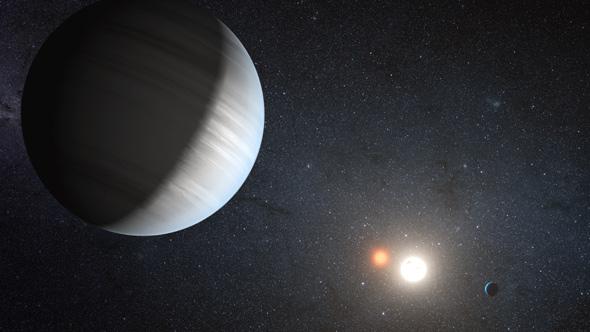Using an old-style observing technique, astronomers have come to a very interesting conclusion: About half of all exoplanets in the galaxy are in binary star systems.
That’s astonishingly cool. Mind you, it’s not unexpected, but now we have some evidence for it.
Here’s the deal. We know that roughly half the stars in the galaxy are in binary systems, with two stars physically orbiting each other. The circumstances that give rise to star formation make it pretty easy for two stars to form near each other (the Sun, of course, being an exception).
We also know that planets are pretty common around stars as well; we know of nearly 2,000 such exoplanets at this point, and thousands more are waiting to be confirmed. It’s natural to put these two ideas together, and ask: How many exoplanets orbit a star in a binary system?
You’d expect the ratio to be the same, but Nature is tricksy sometimes, so it’s best to check. However, that can be tough. Even though a binary companion might orbit a star billions of kilometers out, from light years away the two stars blend into one blob. Even Hubble might not separate the two.
To see what they could see, the astronomers relied on an old method called speckle interferometry. Basically, the Earth atmosphere roils over our heads, with little packets of air flying this way and that. When light from a star passes through them, it gets bent this way and that as well due to refraction. This happens many times per second, so when you take a long exposure the light blurs into a disk. Astronomers call this (confusingly) “seeing.” It’s also why stars appear to twinkle.
But there’s a way around this. Over time the light rays get smeared out, but if you take lots of extremely fast exposures, you freeze that motion out. It’s like taking super slo-mo video. Instead of a big disk, you get a bunch of near-perfect images of the star that jump around in location from image to image, but each frame is a nice, extremely high res shot of the star.
There are limitations to this technique; the star can’t be too faint, or else you won’t get enough light in each frame. There are also limits to the resolution due to telescope size, too. And you need a very sophisticated technique to combine the resulting frames to tease out all the information in them. But speckle interferometry has been around a long time, and its methods are solid (here’s a detailed and technical description).
The astronomers observed a bunch of stars known to have planets (found by the Kepler mission), and then used speckling to see how many had detectable stars very close by. They then used some pretty nifty simulations to find out how many binary companions they might miss—some might be too close to the star to separate even using these techniques. By comparing the two results, they were able to conclude that 40–50 percent of all exoplanets orbit a star in a binary system.
That’s pretty amazing. There are billions of planets orbiting stars in binary system in our galaxy!
What I find most interesting about all this, oddly, is the mundanity of it. Back in the day, we didn’t even know if other planets existed. Was there something special about the Sun that allowed it to host a solar system? Size, chemical content, position in the galaxy? But now we see that a wide variety of stars have planets. Even having another star orbiting the host star doesn’t seem to be a problem!
… well, as long as the other star is far enough out. Closer in, and its gravity could disrupt the planet orbit. But if the stars are close enough together, a planet could orbit both stars. Quite a few such circumbinary exoplanets (I love sciencey words) have been found. I’ve written about a few of them, like Kepler 16b and PH-1b.
Forty years ago this picture was science fiction. Now … well, now not so much.

Photo from LucasFilms
